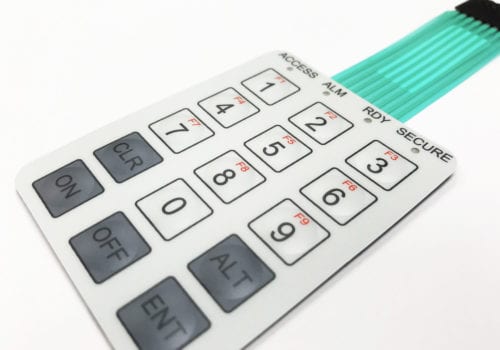Understanding the Functionality of Membrane Layer Changes for Interface Tools
The performance of membrane switches over represents a significant improvement in individual interface design, incorporating effectiveness with visual adaptability. These switches run through a multi-layered framework that converts user communications right into electrical signals, enabling both compact layouts and durability against environmental variables. As markets increasingly focus on individual experience, comprehending the subtleties of membrane switch innovation comes to be vital. What ramifications do these developments hold for future applications, and just how might they redefine individual communications across various devices?
What Are Membrane Layer Buttons?
Membrane buttons are ingenious interface gadgets that help with customer interaction with electronic equipment. These functional components contain multiple layers, including a visuals overlay, spacer, and a printed circuit layer. The style permits a seamless assimilation into various digital tools, boosting both the aesthetic and practical elements of interface.
Membrane layer buttons are generally used in a wide variety of applications, from house devices to commercial equipment and clinical gadgets. Their building usually features a thin account, making them an ideal choice for portable styles. The tactile feedback provided by these buttons can be crafted to meet specific customer choices, making sure efficient communication in between the individual and the device.
Resilience is an additional substantial benefit of membrane buttons, as they are immune to dust, dampness, and chemicals, which improves their lifespan popular settings. Furthermore, these switches can be personalized in terms of shape, dimension, and visuals layout, enabling branding and user-specific attributes. Overall, membrane layer switches over represent a practical remedy for improving user experience in electronic devices, incorporating functionality with visual appeal in a reliable way.
Just How Membrane Switches Job
Operating on a straightforward concept, membrane changes utilize a layered building to register individual input properly. Each switch includes several layers, consisting of a published circuit layer, a spacer layer, and a top visuals layer, which are developed to collaborate perfectly. When a customer presses the top layer, it compresses the spacer layer, bringing the conductive components of the circuit layer into contact with each various other.
This contact creates a shut circuit, signifying the device to carry out a details function. The style enables different setups, consisting of tactile comments, which can improve the customer experience by providing a physical feeling upon activation. The materials made use of in membrane layer buttons frequently include versatile substratums, such as polyester or polycarbonate, which make certain resilience and strength versus wear and tear.

Key Advantages of Membrane Layer Buttons

Another substantial benefit is their compactness. Membrane buttons are thin and light-weight, which allows manufacturers to conserve space in their gadgets without sacrificing performance. This attribute is especially helpful in applications where weight and volume are important considerations.
Furthermore, membrane buttons are immune to dust, moisture, and chemicals, improving their longevity. This durability extends their life expectancy and lowers the need for regular substitutes, resulting in view it expense financial savings over time.
Additionally, the tactile comments offered by membrane layer switches can be maximized to enhance individual communication. They can consist of features such as increased buttons or distinct clicks, improving use and user experience.
Applications Across Industries
Individual user interface tools making use of membrane layer buttons are prevalent in a vast array of markets, showcasing their flexibility and capability. Membrane Switch. In the medical industry, membrane layer buttons are integral to gadgets such as analysis devices and person monitoring systems, where their toughness and convenience of cleaning are important for preserving health standards. Likewise, in the vehicle sector, these buttons are used in control panel controls and infomercial systems, providing a sleek and modern interface for individuals.
Moreover, the customer electronic devices market benefits from membrane switches in appliances and handheld gadgets, where small design and easy to use user interfaces improve individual experience. Industrial applications additionally utilize membrane switches over for control board in machinery and automation systems, emphasizing their robustness and resistance to harsh settings.
In the aerospace and protection markets, membrane switches are made use of in cabin controls and equipment, where integrity and efficiency under extreme conditions are paramount. In addition, the video gaming market increasingly incorporates membrane layer switches in controllers and arcade equipments, adding to an appealing user experience. On the whole, the adaptability of membrane switches over allows their widespread usage across numerous fields, highlighting their significance in modern-day individual interface design.
Future Fads in Membrane Layer Change Modern Technology

Furthermore, making use of advanced materials, such as polycarbonate and polyester movies, is anticipated to climb, providing improved resilience and resistance to environmental stress factors. These products add to the total longevity of membrane buttons, making them appropriate for harsher commercial applications.
Moreover, the unification of smart technology, including IoT connectivity, will make it possible for membrane layer switches to connect with various other gadgets and systems, assisting in an extra interactive individual experience. This trend aligns with the growing need for helpful resources wise gadgets across different fields, from health care to consumer electronic devices.
Lastly, modification choices are expected to expand, allowing producers to create bespoke options tailored to certain individual needs and preferences. These developments will place membrane layer buttons as necessary parts in the advancement of interface innovation.
Conclusion
To conclude, membrane changes stand for a critical development in interface technology, using a reliable and flexible service for diverse digital applications. Their split construction facilitates compact layout, while features such as tactile responses enhance user communication. The durability against environmental variables better strengthens their utility across numerous sectors. As Check Out Your URL innovations in material scientific research and touch picking up modern technologies proceed, the functionality and applicability of membrane layer buttons are anticipated to increase, reinforcing their relevance in contemporary electronic devices.